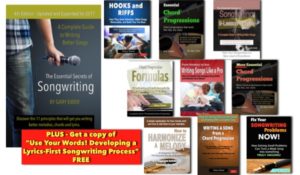When I’m watching a drama on network television, I know that I have to deal with constant stoppages in the action. It’s those commercial breaks that pay the bills, and so they’re important.
Those commercial breaks probably make TV executives very nervous: it’s during the breaks that I’m most likely to switch stations and try something else.
 “Hooks and Riffs: How They Grab Attention, Make Songs Memorable, and Build Your Fan Base” describes exactly how hooks work, how good songwriters layer them in a hit song, and how to make your own song hooks really work well. Get it today!
“Hooks and Riffs: How They Grab Attention, Make Songs Memorable, and Build Your Fan Base” describes exactly how hooks work, how good songwriters layer them in a hit song, and how to make your own song hooks really work well. Get it today!
That’s why the end of every segment of these shows, the bit just before the commercial break, features some kind of mini cliffhanger. Something happens, or someone says something, that makes me think, “Oh, I wonder what that means!”, or “I wonder what’s going to happen next?”
If the cliffhanger is good, I’ll come back to see what in fact does happen next. And usually there is the climactic moment of the show, where everything has been pointing, and if I’ve decided to return to watch what happens next, the show has succeeded.
In a way, songs aren’t that different. The producer (and of course, you, as the songwriter) have to deal with moments in your songs that equate to the TV drama’s “stoppages in the action.” For songwriters, these are the ends of sections, e.g., the end of a verse, a chorus, a bridge, an instrumental solo, etc.
True, you don’t have to deal with several minutes of commercials in the middle of your songs (yet), but there is a kind of “dead zone” that can happen at the end of a section. To be sure that you don’t run the risk of having listeners abandoning your song, you need to be sure that one section begs you to listen to the next one.
This can mean:
- Your verse lyrics need to end by feeling like they need an emotional response. (“So here’s how I feel about all of this.”)
- Your chorus lyrics need to end by stirring up emotions, and maybe even generate a bit of curiosity… (“I’ve felt that way, too.”)
- Your verse melodies need to move higher to connect seamlessly to the start of the chorus.
- Your bridge melodies need to keep the energy building. (Or, if the song is generally high-energy, the bridge needs to allow some energy to diminish, for contrast’s sake.)
- The chord progression for each section needs to end by making it feel that the next section is being set up and prepared.
- The instrumentation/production needs to ebb and flow, building up and then becoming more transparent in an ebb-and-flow kind of way.
There’s probably a lot more I could list here, but you get the picture. At various points along the way, listeners are more likely than at other moments to abandon a song if they lose interest, or can’t seem to care.
As you listen to your songs objectively, you should be able to get a handle on how things are going. You should be able to tell when musical momentum is fizzling. But it requires an ability to listen to one element at a time: read the lyrics, for example, and get a sense of how the end of each section sets you up for the arrival of the next section.
Overall, audiences should pick up a gradual building of energy as a song progresses, but that build is not a straight line. The most important moments are how one section ends and the next one begins. That’s where you want to put your focus when troubleshooting a problematic song.
 Written by Gary Ewer. Follow Gary on Twitter
Written by Gary Ewer. Follow Gary on Twitter
 Excellence happens when you practice your technique. Gary’s 9-Lesson Course takes you through the fundamentals of writing good lyrics, melodies and chords, and helps you understand the concepts of great songwriting structure. It’s part of “The Essential Secrets of Songwriting 10-eBook Bundle.”
Excellence happens when you practice your technique. Gary’s 9-Lesson Course takes you through the fundamentals of writing good lyrics, melodies and chords, and helps you understand the concepts of great songwriting structure. It’s part of “The Essential Secrets of Songwriting 10-eBook Bundle.”










